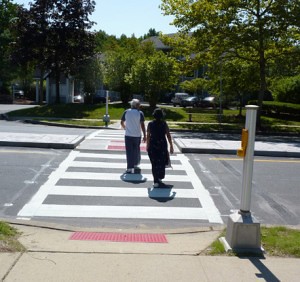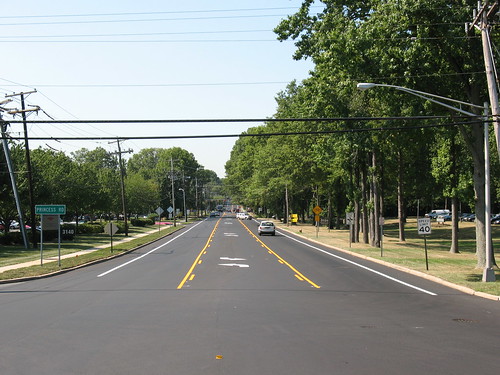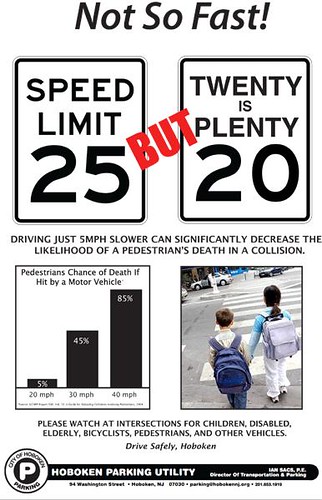 It is no secret that traveling along New Jersey’s roadways can sometimes offer a stressful, heart racing experience. While motorists can often be heard complaining about traffic, construction, and especially the behavior of other drivers, few seem to realize how intimidating it can be for pedestrians who have to walk along and cross these very same roads. The most dangerous places for people to walk are wide, high-speed roads designed to move as many cars as fast as possible. In fact, according to a 2010 report conducted by the Tri-State Transportation Campaign, more than 60 percent of our region’s pedestrian fatalities occur on multilane thoroughfares described by transportation engineers as arterials. Commonly found throughout New Jersey, these arterials typically have at least two lanes in each direction and accommodate prevailing travel speeds of 40 mph or greater. [i]
It is no secret that traveling along New Jersey’s roadways can sometimes offer a stressful, heart racing experience. While motorists can often be heard complaining about traffic, construction, and especially the behavior of other drivers, few seem to realize how intimidating it can be for pedestrians who have to walk along and cross these very same roads. The most dangerous places for people to walk are wide, high-speed roads designed to move as many cars as fast as possible. In fact, according to a 2010 report conducted by the Tri-State Transportation Campaign, more than 60 percent of our region’s pedestrian fatalities occur on multilane thoroughfares described by transportation engineers as arterials. Commonly found throughout New Jersey, these arterials typically have at least two lanes in each direction and accommodate prevailing travel speeds of 40 mph or greater. [i]
For more on Multi- Lane Crossings click the “read more” link below!
Dangerous Crossings
Why are these types of roadways such a challenge to cross? Overall, the street crossing experience is determined by how pedestrians and motorists are influenced by a variety of factors, including both speed and crossing distance. With regard to speed, traveling at a slower rate allows a motorist more time to see, react, and stop for a pedestrian compared to a motorist driving fast. Pedestrians struck at speeds of 40 mph or greater have a dismal 15 percent chance of survival. In contrast, pedestrians hit by cars traveling at 30 mph have a 45 percent chance of surviving the collision. [ii]
 When it comes to crossing the street, generally, the fewer lanes and distance needed to cross, the better the situation for the pedestrian. With a shorter distance to cross, narrower roads help reduce the amount of exposure a pedestrian experiences and generally reduces the likelihood of a collision. Long crossing distances also place pedestrians at an increased risk for a multiple-threat crash. A multiple-threat pedestrian crash is a crash that occurs when a motor vehicle in one lane stops for a pedestrian, providing a visual screen to the motorist in the adjacent lane. Seeing the initial motorist stop, the pedestrian begins to cross. Having not realized why the initial motorist has stopped, the motorist in the adjacent lane continues to move and hits the pedestrian. This type of collision, where the pedestrian is hit in the second, third or fourth lane is common on multilane roads and typically results in a more serious collision due to a higher impact speed.
When it comes to crossing the street, generally, the fewer lanes and distance needed to cross, the better the situation for the pedestrian. With a shorter distance to cross, narrower roads help reduce the amount of exposure a pedestrian experiences and generally reduces the likelihood of a collision. Long crossing distances also place pedestrians at an increased risk for a multiple-threat crash. A multiple-threat pedestrian crash is a crash that occurs when a motor vehicle in one lane stops for a pedestrian, providing a visual screen to the motorist in the adjacent lane. Seeing the initial motorist stop, the pedestrian begins to cross. Having not realized why the initial motorist has stopped, the motorist in the adjacent lane continues to move and hits the pedestrian. This type of collision, where the pedestrian is hit in the second, third or fourth lane is common on multilane roads and typically results in a more serious collision due to a higher impact speed.
Ideas for a Better Walking Environment
To make walking safer and more appealing, we need to embrace strategies that reduce crossing distance, reduce speed, and make pedestrians more visible. While lowering posted speed limits seems like an easy answer, it is often not enough by itself. Without any other changes, simply lowering the speed limit on a given stretch of road may have little effect on driver compliance. Speed limits, which are set below the speed that most motorists perceive to be reasonable for the given road, should be augmented with additional measures to improve compliance. While there are many things that can be done to help, the following are some design ideas for improving the walking environment.

Curb extensions can be a great way to help slow motorists down while shortening crossing distances for pedestrians. Curb extensions narrow the roadway and reduce the crossing distance by extending the sidewalk area into the parking lane. Curb extensions also help to make pedestrians more visible by bringing them out from behind parked cars. This helps both pedestrians and motorists better see each other. Curb extensions can also provide space for curb ramps, help to slow the speed at which vehicles can turn, and prevent motorists from parking on or near a crosswalk.

Pedestrian refuge crossing islands also work to help lower speeds and shorten crossing distances. Crossing islands are raised islands located in the middle of a street that narrow the travel lanes at that location and provide an auto free place for pedestrians to stop, mid-crossing. Crossing islands work by reducing the pedestrian exposure time at a given crossing by breaking the crossing into stages. Crossing islands effectively reduce crossing distance and make crossing easier by allowing pedestrians to focus on one direction of traffic at a time. Crossing islands also make crossing safer and more convenient by providing safe refuge for those who begin crossing too late or who move too slow to cross the entire street in one signal cycle.
One of the best ways to reduce the multiple lane threat to pedestrians is to decrease the width of the road and number of lanes that pedestrians must cross through a “road diet.” With a “road diet,” the through lanes for motor vehicle travel are reduced. The center lane can be supplemented by crossing islands with dedicated left turn pockets at some locations. By reducing vehicle travel lanes, often there is enough room to also install bicycle lanes that help to create a sidewalk buffer for pedestrians. Road diets are a great way to create a balanced transportation system by providing benefits for pedestrians, bicyclists, transit users, and motorists. While extremely effective, another plus is that they can often be accomplished simply with paint, requiring a relatively small cost and no construction.

Princeton Pike in Lawrenceville, NJ after Road Diet application

High visibility crosswalks can help to make crossing pedestrians more visible and to alert motorists to an often used pedestrian crossing. Marked crosswalks benefit pedestrians by directing them to cross at locations where traffic signals exist. It is important that both drivers and pedestrians clearly see the crossings. Crosswalks can be marked in paint or a longer lasting plastic or epoxy material embedded with reflective glass beads. Although more expensive, longer-lasting crosswalk marking materials are a better value over time, as they require less maintenance.

Ensuring the presence of adequate lighting is an important part of making safer crossings. People don’t only walk and cross busy intersections during the day. Without the presence of adequate lighting, none of the strategies discussed above will do much to help pedestrians after the sun goes down. To foster walking as an effective means of transportation within our communities, we need to ensure that people can walk safely and comfortably at any time. By employing some of the strategies discussed above, we will be making walking in our communities a much easier and pleasant experience. By doing this, we will be encouraging more pedestrians to take to the streets, which may also influence motorist behavior. In general, more people walking raises motorist awareness of the likelihood of a pedestrian crossing the street, making it safer for everyone.
FHWA Leading the Way
 Recognizing that pedestrian fatalities continue to be a major highway safety problem in the United States, the Federal Highway Administration (FHWA) has taken the lead nationally to research and develop new resources aimed at increasing pedestrian and bicycle safety and mobility. To address safety concerns and equip professionals with the knowledge, tools, and resources needed for identifying and implementing solutions, the FHWA Office of Safety and Office of Safety Research and Development (R&D) led the effort to create the Pedestrian Safety Strategic Plan: Recommendations for Research and Product Development[iii], issued in October 2010. This Strategic Plan is based on a comprehensive analysis of pedestrian crash data trends and factors, a detailed review of more than 200 reports and publications on pedestrian safety, and input from more than 25 expert stakeholders.
Recognizing that pedestrian fatalities continue to be a major highway safety problem in the United States, the Federal Highway Administration (FHWA) has taken the lead nationally to research and develop new resources aimed at increasing pedestrian and bicycle safety and mobility. To address safety concerns and equip professionals with the knowledge, tools, and resources needed for identifying and implementing solutions, the FHWA Office of Safety and Office of Safety Research and Development (R&D) led the effort to create the Pedestrian Safety Strategic Plan: Recommendations for Research and Product Development[iii], issued in October 2010. This Strategic Plan is based on a comprehensive analysis of pedestrian crash data trends and factors, a detailed review of more than 200 reports and publications on pedestrian safety, and input from more than 25 expert stakeholders.
The Strategic Plan recommends research direction, product development, and delivery activities for the next 15 years and identifies 28 new research topics to address: 1) problem identification and data collection; 2) analysis and decision making; 3) innovative research and evaluation; and 4) technology transfer. The new research will focus on activities that target pedestrian crash problems with the highest frequency and address pedestrian crash factors using a strategic, comprehensive approach. The aim of the research will be to provide quantitative assessments of pedestrian safety strategies to assist engineers and planners select effective measures to enhance pedestrian safety.
In order to summarize and simplify information, increase understanding of issues and products, and update products, the Strategic Plan also recommends updates to existing FHWA technology transfer tools and resources based on an evaluation by potential end-users and to disseminate information through event marketing, successful practices guides, in-person and web-based training, and software development.
The importance of interagency collaboration to successful plan implementation is highlighted and potential barriers are identified along with possible solutions. The Plan includes a timeline for activities, covering the full 15-year period as well as strategies for plan review, evaluation, and updates so as to help ensure that the Strategic Plan will serve as a flexible, living document. Recommendations for research and product development are intended to be addressed through collaboration between various agencies and offices.[iv]
Through its Strategic Plan, leadership in the research and development of new tools, and reassessment of existing products and materials, the FHWA has helped to create a sense of national urgency for making it safer for pedestrians, bicyclists, and motorists to share our roadways safely. In all, by using existing tools and strategies and embracing those newly developed, offering pedestrians a future where dangerous crossings are no longer a reality becomes truly feasible.
For more information, please contact the NJ Bicycle and Pedestrian Resource Center at bikeped@ejb.rutgers.edu

